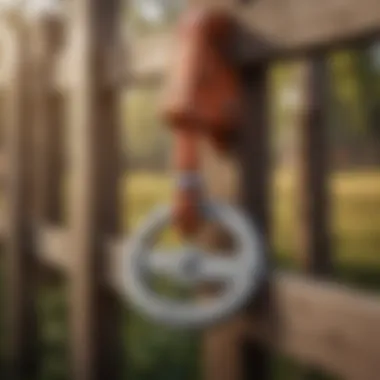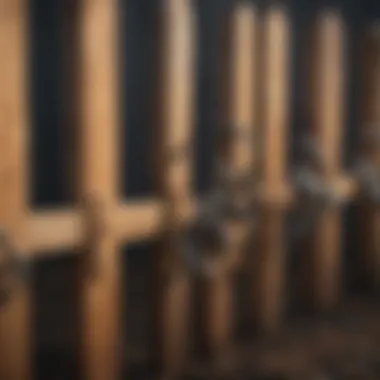Understanding the Role of Fence Pullers in Agriculture


Intro
Fence pullers are an essential tool for any agricultural professional or hobbyist. They facilitate the installation and maintenance of fences, which are vital for animal control and land management. Understanding their mechanics and applications can greatly enhance efficiency on the farm. This article will detail key concepts, recent innovations, and practical applications of fence pullers, providing a comprehensive guide to their effective use.
Key Concepts and Terminology
Basic Definitions
A fence puller is a mechanical device that helps stretch wire fencing materials tight. This tool is critical in ensuring a securely fastened fence, which protects livestock and manages land use. There are various types of fence pullers available, each designed for specific wire types and installation situations.
Historical Context
The evolution of fence pullers can be traced back to the development of wire fencing itself. Early agriculturalists utilized primitive methods to secure boundaries, which often lacked efficiency. As fencing technology progressed, the need for better tools became evident. Fence pullers emerged to meet this demand, evolving alongside changes in farming practices and fencing materials.
Recent Innovations and Trends
Technological Advancements
Recent innovations in fence pullers have led to more efficient designs. Modern pullers often feature improved mechanical principles that maximize leverage and minimize physical strain on the user. Additionally, some models incorporate materials like lightweight alloys that enhance durability without adding excess weight. These advancements make it easier for farmers to install fences quickly and effectively.
Sustainable Practices
The adoption of sustainable farming practices is increasingly intertwined with the use of modern fence pullers. Sustainable practices often require the use of efficient tools that minimize labor and maximize results. By utilizing fence pullers, farmers can reduce time and resource expenditure, benefitting both their operations and the environment.
Practical Applications and Techniques
Step-by-step Guides
- Choosing the Right Puller: Identify the type of wire you will be using. Different pullers are suited for different wire gauges and materials.
- Preparing the Area: Clear the area where the fence will be installed. Ensure there are no obstacles that may obstruct installation.
- Setup: Secure the fence puller to the starting point of your fence. Follow the manufacturer’s instructions for optimal results.
- Stretching the Wire: Engage the puller to begin tensioning the wire. Monitor closely to prevent over-stretching, which can cause breakage.
- Securing the Fence: Once the wire reaches the desired tension, secure it in place using the appropriate clamps or fasteners.
Case Studies
Numerous farms have benefitted from using various types of fence pullers. In one case, a small cattle farm in Texas implemented a mechanical fence puller to assist with fencing installation. The owner reported a significant reduction in installation time and an increase in overall fence quality.
Using the right tools like fence pullers is vital for sustainable farming. It not only improves efficiency but also enhances animal safety and land management.
Closure
As we conclude this overview of fence pullers, it's evident that these tools play a foundational role in modern agriculture. Understanding their function and proper usage can lead to more effective farming practices and sustainability in the field.
Preamble to Fence Pullers
In modern agriculture, efficient land management practices are essential. Among various tools that assist in this endeavor, fence pullers have gained significant attention. These devices play a vital role in the installation and maintenance of fencing systems, which are crucial for effective animal control and delineating property boundaries. Understanding fence pullers, therefore, is not just about the tools themselves, but also encompasses their utility, mechanism, and the benefits they offer to farmers and land managers alike.
Definition and Purpose
A fence puller is a mechanical device designed to tension and secure fencing materials, such as barbed wire, chain link, or electric fence strands. Essentially, it allows the operator to stretch the fence wire to the appropriate tightness and to attach it to fence posts swiftly and securely. This tool minimizes labor time during fence installation and enhances the overall durability of the fence.
The purpose of using a fence puller extends beyond mere installation. A well-maintained fence is crucial in preventing livestock from escaping and protecting crops from animal damage. Moreover, pulling the wire correctly ensures that the fence remains taut over time, reducing the chances of sagging or damage from environmental factors.
Historical Context
The concept of fence pullers dates back to the early days of agricultural development. Initially, farmers relied on manual techniques, often utilizing simple tools like levers or pulleys. As the demand for secure fencing grew, particularly in livestock farming, the need for more efficient devices emerged.
With industrial advancements in the late 19th and early 20th centuries, mechanical devices began to surface. The evolution of fence puller technologies has continued, leading to the introduction of hydraulic and powered models designed to ease the physical strain on operators and improve tension accuracy. Today, a variety of models are available, catering to different types of farmers and their specific fencing needs.
Overall, understanding fence pullers is essential for anyone involved in agricultural practices. It provides insight not only into the tools themselves but also into the broader implications of effective fencing for agricultural productivity and sustainability.
Types of Fence Pullers
Understanding the various types of fence pullers is crucial. Each type serves unique functions and has its special methods of operation. Selecting the right kind affects the efficiency of fencing installation, maintenance, and overall effectiveness in agricultural practices. The different designs adapt to the varying demands of fencing jobs, whether they involve light-duty tasks or heavy, extensive installations. This section will examine three main categories: manual, mechanical, and hydraulic fence pullers.
Manual Fence Pullers
Manual fence pullers are basic tools that require human strength to operate. They are often favored for their simplicity and low cost. These devices typically consist of a lever mechanism that allows the user to increase their pulling force significantly. Manual pullers might include devices like the simple winch or fence stretcher.
Some benefits of manual fence pullers include:
- Cost-effective: Generally cheaper than mechanical or hydraulic options.
- Easy to maintain: Fewer moving parts and no complex mechanisms simplify upkeep.
- Portable: Lightweight and easy to transport, making them suitable for remote areas without power sources.
Despite their usefulness, there are considerations. Users must be physically capable, as they require significant manual effort. Over time, repeated use can lead to fatigue, especially on larger jobs, diminishing productivity. Thus, while they are beneficial for smaller projects or quick fixes, relying on them for extensive installations might not be practical.
Mechanical Fence Pullers
Mechanical fence pullers use gear systems or powered mechanisms to help stretch and secure fencing material. Thye are generally more efficient than manual counterparts and can handle heavier workloads. Their design often permits operators to secure a fence efficiently without much physical strain.


The advantages of mechanical pullers include:
- Reduced physical strain: The mechanical advantage allows users to exert less effort.
- Increased effectiveness: Capable of handling tougher materials and larger areas ensures a more stable and secure installation.
- Adjustment options: Many mechanical pullers offer adjustable settings for different tasks, making them versatile.
However, mechanical models may come with higher initial costs and require regular maintenance. Depending on the complexity of the mechanism, users may need training to operate effectively. Therefore, it is essential to weigh the extra investment against the time and labor savings.
Hydraulic Fence Pullers
Hydraulic fence pullers are advanced tools that utilize hydraulic pressure to pull and stretch fencing materials. They offer the strongest pulling power, making them suitable for heavy-duty applications. These pullers are ideal for professional and large-scale agricultural jobs.
Key aspects of hydraulic pullers include:
- High pulling capacity: They can exert tremendous force, suitable for strong materials and long stretches of fencing.
- Efficient and fast: Hydraulic systems allow for rapid adjustments, increasing job efficiency.
- User control: Many models come with controls that allow fine-tuning of tension, ensuring proper installation without material damage.
The trade-offs involve higher costs and the necessity for a power source. Moreover, thorough training is essential for smooth operation and safety, as incorrect use can lead to accidents. Overall, for significant agricultural operations where durability and longevity are priorities, hydraulic options present valuable advantages.
Hydraulic pullers stand at the forefront of reliability and efficacy in large installations, marking a significant evolution in fencing technology.
Mechanics of Fence Pullers
The mechanics of fence pullers encompass the core operational principles that make these tools effective for agricultural uses. Understanding the mechanics behind fence pullers is essential for farmers and enthusiasts who wish to optimize their fencing projects. A well-designed fence puller enhances productivity, ensuring the swift installation and repair of fences across varied landscapes. In this section, we will discuss the basic design elements and the critical aspects of force application and tension management, both of which are integral to the functionality of these devices.
Basic Design Elements
The design of a fence puller can vary widely based on its type and intended use, but several basic elements are common across most models. A typical fence puller features a strong, durable frame that can withstand substantial forces. This design is crucial for effectively pulling tight wires or cables without bending or breaking.
Key components include:
- Handle: For manual versions, the handle provides the leverage needed to exert force. In mechanical versions, the handle may engage gears or hydraulic systems.
- Grip: Proper grip ergonomics are important, allowing the user to control the puller effectively while preventing slippage.
- Pulley System: Many fence pullers utilize a pulley mechanism to reduce the required force. This system redirects the pull by changing the line of action, allowing for easier tightening of materials.
- Attachment Points: These are critical to connect the tool to the wire or for anchoring to fixed points, providing stability during operation.
The combination of these elements determines the overall efficiency and effectiveness of a fence puller. Proper attention to the design can improve user experience and enhance the tool's longevity.
Force Application and Tension Management
Effective force application and tension management are paramount in the operation of fence pullers. Successful fencing requires that materials be pulled with sufficient tension to maintain structural integrity while avoiding breakage.
Here are some key considerations regarding this aspect:
- Understanding Tension: Tension is the force exerted along the length of the wire. Applying the correct tension ensures the fence remains taut, preventing sagging or loosening over time.
- Using Leverage: Many fence pullers are designed to maximize torque. For example, a longer handle will enable the user to generate more force, making it easier to pull cables tight.
- Gradual Force Application: It's crucial to apply force slowly and steadily. Rapid or excess pulling can lead to material failure or damage to attachments.
- Tension Indicators: Some modern fence pullers come with built-in tension indicators that give feedback on the current level of tension. This feature can prevent over-tightening, which may compromise the fence's longevity.
The mechanics of fence pullers not only define their usability but also influence the outcomes of fencing projects. Proper understanding and application of tension can lead to greater durability and efficiency in agricultural practices.
Factors Influencing Fence Puller Selection
The choice of a fence puller is critical for achieving effective agricultural operations. This selection process hinges not only on the type of fence being used but also on the specific conditions under which the fence puller will operate. Understanding these factors allows farmers and agricultural enthusiasts to optimize their fencing projects, ensuring efficiency and durability in their setups. Selecting the right tool can ultimately lead to better land management and improved animal control practices.
Fence Material Considerations
The materials that constitute the fence significantly inform the choice of a fence puller. Different materials have varying levels of strength, flexibility, and weight, necessitating different pulling techniques and equipment. For instance, wooden posts may demand a different approach compared to chain-link fences. Wooden fences often require tension to be managed carefully during installation to prevent splintering or breaking. Conversely, chain-link structures may utilize a more uniform tension along the wire, making a stronger puller necessary.
Other materials like barbed wire or electric fencing introduce additional challenges. Barbed wire, known for its sharp edges, necessitates precise handling to avoid damaging the wire while ensuring it is pulled taut enough to prevent drooping. Electric fences require specialized pullers that can navigate the wires without causing electrical malfunctions. Therefore, understanding the specific demands of the material can lead to a smart selection of the best fence puller, enhancing overall installation effectiveness.
Terrain and Environmental Conditions
The type of terrain where the fence will be installed is another determinant of the right fence puller. Uneven or rocky ground presents unique challenges that require a more robust pulling mechanism, often found in mechanical or hydraulic pullers. Flat terrain may allow for the use of lighter manual pullers, but these still need to account for factors such as soil type and moisture levels. Wet, boggy ground can sap the power of a puller, while hard-packed soil can increase resistance during installation.
Additionally, weather plays a crucial role. Wet or icy conditions can create slipperiness that poses risks while operating a fence puller, potentially causing accidents or equipment damage. Seasonal considerations should be taken into account, as some materials may behave differently under temperature fluctuations. Thus, selecting a suitable puller requires evaluating both terrain features and environmental conditions to reduce operational difficulties and improve safety.
To ensure success in fence installations, one must assess both material properties and environmental challenges. These factors guide the selection of an appropriately suited fence puller.
Practical Applications of Fence Pullers
Fence pullers play a vital role in various agricultural practices. They are indispensable tools for anyone involved in fencing, from setting up boundaries to securing pastures for livestock. Understanding their practical applications optimizes efficiency and ensures effective animal control, improving overall farm management.
Fencing Installation Techniques
The installation of fencing is critical for agricultural enterprises. A fence not only defines property lines but also keeps livestock contained and protects crops. Utilizing a fence puller during installation aids in achieving taut fencing, which prevents sagging and reduces vulnerability to adverse weather conditions.
When installing a fence, several techniques can be emphasized:
- Alignment and Leveling: Fence pullers help in aligning fence posts properly. Ensuring they are straight and evenly spaced is crucial for aesthetics and functionality.
- Tensioning: The tension is fundamental in maintaining the integrity of the fence structure. By using a fence puller, farmers can apply the necessary force to stretch wire or cables tightly along the posts. This eliminates slack and prevents the fence from becoming loose over time.
- Post Setting: After holes are dug, a fence puller can assist in positioning posts and holding them upright while concrete or dirt is packed around them.
Maintenance and Repairs
Maintenance of existing fencing is just as important as initial installation. Fences can degrade over time due to environmental factors or animal interference. Regular inspections and timely repairs are essential for maintaining their effectiveness. Fence pullers are beneficial in various maintenance tasks:


- Repairing Loose Sections: When certain sections of a fence sag, a fence puller can re-tension the wire or cable, restoring its original stability and preventing future issues.
- Replacing Damaged Components: If a post or section of wire needs replacement, the fence puller can facilitate easier access and realignment, allowing the process to be more efficient.
- Seasonal Adjustments: Seasonal environmental changes can affect fence tension. Utilizing a fence puller allows for adjustments based on these changes, which is especially important in regions with fluctuating temperatures or high winds.
"Investing in a reliable fence puller not only saves time but also enhances the longevity of your fencing solutions."
In summary, the practical applications of fence pullers in installation and maintenance underscore their importance in agricultural practices. These tools minimize labor efforts while maximizing the effectiveness of fencing, ultimately contributing to better farm management and animal welfare.
Safety Considerations
Safety considerations are paramount when working with fence pullers. These tools, while efficient for installing and maintaining fences, can pose risks if not handled properly. Understanding the potential hazards and implementing safe practices can significantly reduce the likelihood of accidents on a job site.
Proper Handling Techniques
Proper handling techniques ensure that users can operate fence pullers safely. Here are some key practices:
- Read the Manual: Always familiarize yourself with the manufacturer's instructions. This helps in understanding the specific features and limitations of your fence puller.
- Safety Gear: Wear appropriate personal protective equipment (PPE) such as gloves, eye protection, and steel-toed boots. These items can protect you from injuries.
- Stable Setup: Ensure that the fence puller is set up on level ground. An unstable base can cause the puller to tip over, leading to injuries.
- Grip Control: Always maintain a firm grip on the puller when in use. A slip can lead to unexpected movements, causing harm.
- Team Work: If possible, use the assistance of another person, especially with larger fence pullers. This provides an extra set of eyes and hands to manage the equipment safely.
Tracking adherence to these practices will help mitigate risks associated with handling fence pullers.
Common Hazards
Recognizing common hazards associated with fence pullers is crucial for safe operation. These hazards include:
- Pinch Points: When operating the puller, keep fingers and hands away from moving parts. Pinch points can crush or pin limbs, causing significant injuries.
- Recoil Risks: Under certain conditions, the fence wire or tension could suddenly release. This often causes recoil, which can hit the operator or nearby personnel. Therefore, always ensure that the tension is managed correctly.
- Trip Hazards: The area around the worksite should be clear of debris and obstacles. Uneven terrain can lead to tripping over tools or material related to the job.
- Equipment Failure: Regular inspections of the fence puller are necessary. Identify any wear and tear or malfunctioning parts before using the equipment. An unexpected break can cause accidents.
"Awareness and diligence regarding safety procedures can prevent many common accidents associated with using fence pullers."
By implementing these considerations systematically, users can ensure a safer working environment while utilizing fence pullers effectively in agricultural contexts.
Innovations in Fence Pulling Technology
The realm of agricultural tools continues to evolve, with innovations in fence pulling technology playing a significant role in improving efficiency and sustainability. As the demand for better land management and animal control increases, the integration of advanced technology in fence pullers becomes critical. These innovations enhance the effectiveness of fencing installations, make maintenance easier, and offer solutions aligned with modern environmental concerns.
Smart Technologies and Fence Pulling
Smart technologies are revolutionizing how farmers approach fence installation and maintenance. With the integration of IoT devices, farmers can now monitor the status of their fencing systems remotely. This technology allows for real-time data collection on tension, alignment, and potential damages, enabling timely interventions. The benefits of these smart systems are clear:
- Improved Monitoring: Through sensors, farmers can receive alerts when a fence is compromised or requires adjustment.
- Data Analysis: Accumulated data can be analyzed to optimize the positioning and material use for fences, thus enhancing durability.
- Automation: Certain smart pullers can automate the tensioning process, reducing human error and ensuring consistent performance.
Investing in smart fence pulling technology is not only about increasing productivity; it also supports sustainability by minimizing material waste and reducing the need for frequent repairs.
Sustainable Materials and Design
In recent years, the focus on sustainability has led to the development of fence pullers made from eco-friendly materials. Using sustainable materials not only reduces the environmental impact but also ensures long-lasting performance. Some aspects of this innovation include:
- Recycled Materials: Many new fence pullers utilize recycled plastics and metals, promoting a circular economy.
- Energy-Efficient Designs: Innovations include designs that require less energy to operate, contributing to lower carbon footprints during use.
- Biodegradable Options: There is research underway into creating biodegradable components for fence pullers, reducing landfill waste.
Adopting these sustainable practices is becoming increasingly relevant in agriculture, aligning with broader goals of environmental stewardship. It is essential for farmers to consider where their tools come from and how they affect the ecosystem.
Investing in innovation not only enhances farm efficiency but also contributes to the sustainability of agricultural practices.
The future of fence pulling technology is bright, with continuous advancements that address both practical and ecological concerns. Farmers and agricultural enthusiasts should stay informed about these innovations to maintain a competitive edge while protecting the environment.
Economic Implications of Using Fence Pullers
The economic implications of using fence pullers are significant for those involved in agricultural practices. Efficient fencing is essential for managing livestock, protecting crops, and establishing boundaries. Understanding how these tools contribute to economic efficiency can help stakeholders make informed decisions regarding their usage. Below, we will delve into the cost-benefit analysis and the impact on labor efficiency that fence pullers bring to agricultural environments.
Cost-Benefit Analysis
When considering the investment in fence pullers, a thorough cost-benefit analysis is critical. The initial cost of purchasing a quality fence puller can appear high, but the long-term savings and productivity gains often justify this investment. Let's examine a few key elements of this analysis:
- Initial Investment: The price of mechanical or hydraulic fence pullers varies significantly based on brand and technical features. High-quality models can range from several hundred to thousands of dollars.
- Operational Costs: These include maintenance fees, fuel costs (for mechanical models), and potential repair expenses. Regular maintenance can prolong the lifespan of the equipment and prevent costly breakdowns.
- Time Savings: A well-chosen fence puller reduces the time needed for installation and maintenance. Manual installations can take hours or even days, while using a puller can cut that time significantly. Faster completion improves productivity on the farm.
- Labor Costs: Reducing the time needed for fencing tasks allows farmers to allocate labor to other essential areas, enhancing overall operational efficiency without increasing workforce size.
In assessing these factors, the use of fence pullers clearly presents a compelling case for economic consideration in agricultural operations.
Impact on Labor Efficiency
Labor efficiency is a critical component to consider when evaluating the use of fence pullers. Better tools lead to better performance. Here’s how fence pullers influence labor:
- Reduction in Physical Strain: Traditional fence installation methods often require significant manual labor, which can lead to worker fatigue and injury. Fence pullers minimize physical strain, allowing workers to perform tasks without excessive effort or risk of injury.
- Increased Output: With efficient tools, farmers can complete more fencing projects in less time. This increase in output allows for the more effective management of land and resources.
- Skill Requirement: Some fence pullers require minimal training compared to manual methods. This ease of use means that tasks can be performed by a broader range of workers, thereby increasing flexibility in labor allocation.
"Fence pullers not only enhance productivity but also contribute to workplace safety, making them a valuable investment in agricultural productivity."
Case Studies
Case studies play a crucial role in understanding the practical applications of fence pullers in various agricultural settings. These studies provide real-world examples showcasing how different types of fence pullers are utilized to enhance efficiency in fencing tasks. By examining successful implementations and analyzing failures, we can glean insights that support better practices moving forward. Case studies help pinpoint best methodologies, illustrate challenges encountered, and demonstrate innovations in fence pulling technology. They also foster a dialogue among professionals and enthusiasts, facilitating knowledge sharing and continuous improvement in the industry.


Successful Implementations
Successful implementations of fence pullers often showcase best practices in the field. For instance, in a large-scale cattle ranching operation, mechanical fence pullers were employed to streamline the process of erecting barbed wire fencing. The crew experienced significant time savings and reduced labor costs. This case significantly highlights how combining technology with traditional practices can optimize operations.
Such implementations often include:
- Time efficiency: By minimizing manual labor, the overall fencing time is cut down significantly.
- Cost reduction: Less workforce is required, leading to lower operational costs.
- Improved safety: Mechanical devices decrease the risk of human injury.
These examples encourage others in the agricultural community to adopt similar approaches that lead to enhanced productivity and safety in their fencing projects.
Lessons Learned from Failures
Analyzing failures related to fence pullers can be as informative as studying successes. A common issue arises when improper selection of a fence puller leads to inadequate tension application, resulting in fence sagging or damage. For instance, one farmer reported using a manual fence puller for high-tension wire fencing, which proved to be inefficient and resulted in the need for repairs soon after installation.
These failures emphasize important lessons:
- Choose the right tool: It's essential to evaluate the specific requirements of the fencing task and select an appropriate fence puller.
- Proper training: Personnel need adequate training to handle equipment effectively, reducing errors in installation.
- Routine maintenance: Regular checks and maintenance of pullers can prevent equipment failure and prolong their lifespan.
By learning from past mistakes, farmers can minimize risks and enhance the durability of their fencing efforts.
Sustainable Practices in Fence Installation
The focus on sustainable practices in fence installation is becoming increasingly significant as agriculture adapts to modern challenges. Implementing sustainable methods not only enhances the efficiency of fencing but also respects the environment. As the need for sustainable agriculture rises, understanding how fence pullers can contribute to this goal is essential for farmers and enthusiasts alike.
Minimizing Land Disturbance
When installing fences, minimizing land disturbance is vital for preserving soil health and the surrounding ecosystem. Using fence pullers designed to reduce ground impact can significantly help. These specialized pullers apply force more evenly across the landscape, thus preventing soil compaction and disruption of natural habitats.
Farmers can benefit from the following practices:
- Using lighter equipment: Lightweight fence pullers are less likely to compact the soil.
- Choosing strategic installation points: By scouting the land carefully, one can avoid areas that are fragile or prone to damage.
- Scheduling installations during dry seasons: This tactic reduces the potential for soil erosion and allows the environment to recover more quickly post-installation.
"Sustainable practices require that we rethink our approaches, striving for methods that not only serve us but the land that supports our livelihood."
By integrating these practices into the installation process, the longevity of the land’s productivity is preserved, creating a win-win situation for agriculture and the environment.
Promoting Biodiversity
In addition to minimizing land disturbance, promoting biodiversity during fence installation plays a crucial role. Fences can act as barriers, but they can also serve as conduits if designed thoughtfully. Certain practices can support local ecosystems while ensuring effective animal control.
Strategies to encourage biodiversity include:
- Using native plants: Fencing designs that incorporate native vegetation provide habitats for numerous species.
- Leaving gaps or corridors: These features can allow wildlife to move freely, which is essential for maintaining healthy populations.
- Employing eco-friendly materials: Using sustainable resources for fence construction is vital in promoting a healthy environment.
Being mindful of biodiversity when installing fences fosters a balanced ecosystem and contributes to more resilient landscapes. Farmers and landowners will increasingly find that fences can coexist with nature if planned properly.
Future Trends in Fence Pulling
The landscape of agriculture is changing due to advancements in technology and shifts in market needs. Understanding future trends in fence pulling is vital for farmers and agricultural enthusiasts. These trends affect how fencing is designed, maintained, and utilized. In this section, the focus will be on two key aspects: emerging technologies in fence pulling and projected market developments.
Emerging Technologies
In today's agricultural environment, several emerging technologies are set to transform fence pulling. CNC (computer numerical control) machinery is increasingly used to produce high precision fence components. Improved materials, such as composite fibers, offer better durability and lower maintenance costs. Additionally, GPS technology facilitates accurate placement and alignment of fences, enhancing the efficiency of fencing installations.
Automation is also taking a prominent role. Robotic fence pullers are being developed to reduce labor costs while increasing the pace of installation. For situations requiring considerable tension, applications of hydraulic technology ensure better force distribution across the fence line.
These advancements bring multiple benefits, including reduced labor intensity, greater accuracy, and increased lifespan of fencing systems. Farmers can look forward to tools that not only accomplish tasks more swiftly but integrate seamlessly with other farm management solutions.
Projected Market Developments
Market developments indicate a growing demand for innovative solutions in fence pulling. As sustainable farming practices become more mainstream, the emphasis on environmentally friendly materials is rising. This shift is likely to push manufacturers to invest more in research and development. It is essential for producers to stay updated on these changes.
The market is also likely to experience increased competition due to the entry of new players. Startups with tech-savvy approaches may disrupt the traditional fencing industry. Farmers should be prepared to evaluate a wider range of options, considering both cost-effectiveness and long-term value.
"Staying informed about the market can give farmers a competitive edge and lead to better decision-making in their operations."
Another aspect to consider is the impact of consumer preferences. As farm-to-table movements gain traction, consumers are requesting greater transparency on how food is sourced and produced. The role of durable and sustainable fencing solutions may hold more significance as production practices become more publicly scrutinized.
Culmination
The conclusion of this article encapsulates the essential concepts surrounding fence pullers and their significant role in agriculture. Understanding the mechanics, types, and applications of these tools is vital for farmers and agricultural enthusiasts aiming to improve their fencing projects.
Summary of Key Points
- The article emphasizes that fence pullers are crucial tools in fencing installation and maintenance.
- Different types of fence pullers, including manual, mechanical, and hydraulic varieties, cater to specific tasks and conditions.
- Essential design elements and force management principles enhance the efficacy of these tools.
- Factors such as terrain, material types, and environmental conditions heavily influence the selection of a suitable fence puller.
- Safety considerations are paramount and include proper handling techniques and awareness of potential hazards.
- Innovations in fence pulling technology, including smart technologies, show promise for the future and sustainability of farming practices.
- Economic implications, such as labor efficiency and cost-benefit analyses, highlight the impact of these tools on farm operations.
- Real-life case studies illustrate successful implementations and lessons from failures.
- Sustainable practices, like minimizing land disturbance and promoting biodiversity, can be enhanced with proper use of fence pullers.
Final Thoughts on Future Use
In the evolving landscape of agriculture, fence pullers will remain a vital tool. As technology advances, further innovations in design and functionality are expected, potentially integrating features like remote operation and improved material science for better durability. The future of fencing practices can benefit from sustainable approaches that minimize environmental impact, all while maintaining effectiveness and efficiency in installation and maintenance.
Farmers and agricultural professionals should embrace these advancements and consider them in their operations. By doing so, they not only improve productivity but also contribute to a more sustainable agricultural practice that respects the land and its ecosystems. Understanding and utilizing fence pullers effectively will continue to shape the agricultural sector in meaningful ways.















